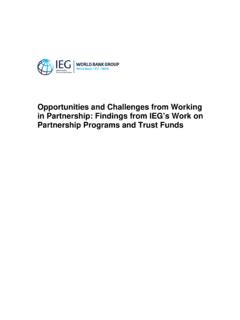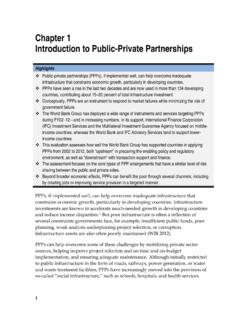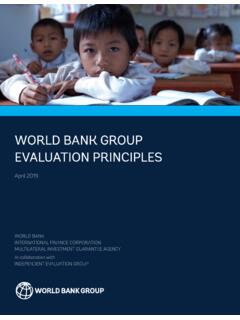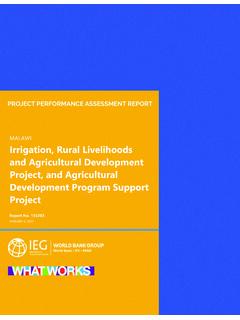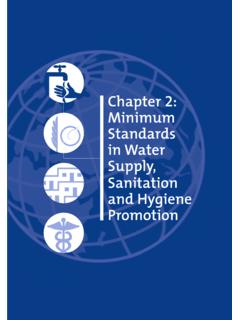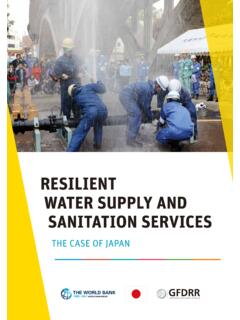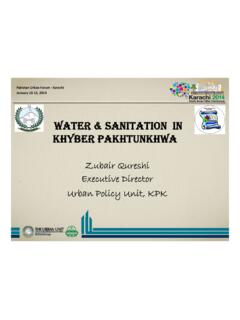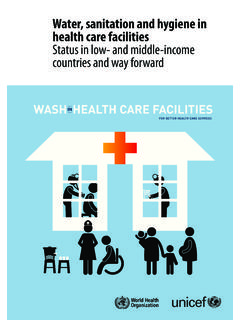Transcription of SRI LANKA Second Community Water Supply and Sanitation …
1 Report No. 115781 JUNE 26, 2017 SRI LANKA Second Community Water Supply and Sanitation Project 2017 International Bank for Reconstruction and Development / The World Bank 1818 H Street NW Washington DC 20433 Telephone: 202-473-1000 Internet: Attribution Please cite the work as follows: World Bank. 2017. Project Performance Assessment Report: Sri LANKA Second Community Water Supply and Sanitation Project. Washington, DC: World Bank. This work is a product of the staff of The World Bank with external contributions. The findings, interpretations, and conclusions expressed in this work do not necessarily reflect the views of The World Bank, its Board of Executive Directors, or the governments they represent.
2 The World Bank does not guarantee the accuracy of the data included in this work. The boundaries, colors, denominations, and other information shown on any map in this work do not imply any judgment on the part of The World Bank concerning the legal status of any territory or the endorsement or acceptance of such boundaries. RIGHTS AND PERMISSIONS The material in this work is subject to copyright. Because The World Bank encourages dissemination of its knowledge, this work may be reproduced, in whole or in part, for noncommercial purposes as long as full attribution to this work is given. Any queries on rights and licenses, including subsidiary rights, should be addressed to World Bank Publications, The World Bank Group, 1818 H Street NW, Washington, DC 20433, USA; fax: 202-522-2625; e-mail: Report No.
3 :115781 PROJECT PERFORMANCE ASSESSMENT REPORT SRI LANKA Second Community Water Supply AND Sanitation PROJECT (CH035) June 26, 2017 Financial, Private Sector, and Sustainable Development Independent Evaluation Group ii Currency Equivalents (annual averages) Currency Unit = Sri Lankan rupees (SL Rs) 2003 US$ SL Rs 2005 US$ SL Rs 2007 US$ SL Rs 2009 US$ SL Rs 2011 US$ SL Rs 2016 US$ SL Rs Abbreviations and Acronyms ADB Asian Development Bank CBO Community -based organization CWSSP Community Water Supply and Sanitation Project DNCWS Department of National Community Water Supply ERR economic rate of return FGD focus group discussion GDP gross domestic product ICR Implementation Completion and Results Report ISR Implementation Status and Results Report IDA International Development Association IEG Independent Evaluation Group JICA Japan International Cooperation
4 Agency M&E monitoring and evaluation MOH medical officers of health NWSDB National Water Supply and Drainage Board PPAR Project Performance Assessment Report RSC regional support center RWS Rural Water and Sanitation Section RWSS rural Water Supply and Sanitation SDR special drawing rights All dollar amounts are dollars unless otherwise indicated. Fiscal Year Government: January 1 December 31 Director-General, Independent Evaluation: Ms. Caroline Heider Director, IEG Financial, Private Sector, and Sustainable Development: Mr. Jos C. Carbajo Martinez Manager, IEG Sustainable Development: Ms. Midori Makino Task Manager: Mr.
5 Katsumasa Hamaguchi iii Contents Principal Ratings .. v Key Staff v vii Summary .. viii 1. Background and 1 Country Background .. 1 Sector Background .. 1 World Bank Support .. 5 2. Objectives, Design, and Their Relevance .. 5 Components and Costs .. 5 Financing and 7 Relevance of Objectives .. 7 Relevance of Design .. 8 Monitoring and Evaluation .. 9 3. Implementation .. 10 Safeguards and Fiduciary Compliance .. 11 4. Achievement of the Objectives .. 12 Objective 1: To Increase Service Coverage .. 12 Objective 2: To Achieve Effective and Sustained Use .. 14 5. Efficiency .. 20 6. Ratings .. 21 Outcome.
6 21 Risk to Development Outcome .. 22 World Bank Performance .. 23 Borrower Performance .. 24 7. Lessons .. 25 References .. 26 Figures Figure Trend of Access to Improved Water Supply , 2000 15 .. 2 Figure Trend of Access to Improved Sanitation , 2000 15 .. 2 This report was prepared by Katsumasa Hamaguchi, who visited Sri LANKA along with Ramachandra Jammi and Nilakshi De Silva. The report was peer reviewed by Richard W. Pollard and panel reviewed by Ridley Nelson. Romayne D. Pereira provided administrative support. iv Figure Percentage Distribution of Households by Water Supply and Sanitation Services, 2012/13.
7 3 Figure Institutional Structure for Rural Water Supply in Sri LANKA .. 4 Figure Institutional Structure for Rural Sanitation .. 4 Figure Households with Sufficient Water for Drinking, Bathing, and Washing, by 15 Figure Satisfactory Ratio of Sampling Tests .. 16 Figure Water Quality and Water -Borne Disease .. 16 Figure CBO s Self-Assessment of Water Quality of Schemes Supported by the Project .. 17 Figure Households with Toilet Facility .. 20 Tables Table Uneven Development across the Urban, Rural, and Estate Sectors .. 1 Table Project Costs by 7 Table Financing .. 7 Table Project Sites Visited by the PPAR Mission.
8 12 Table Key Output Indicators .. 13 Table Key Outcome Indicators .. 14 Table Source of Water by Use in CBOs Where FGDs Took Place .. 15 Table Water Quality Testing by CBOs Where FGDs Took 18 Appendixes Appendix A. Basic Data 29 Appendix B. Summary of Focus Group Discussions .. 32 Appendix C. List of Persons Met .. 36 v Principal Ratings ICR* ICR Review* PPAR Outcome Moderately satisfactory Moderately satisfactory Moderately satisfactory Risk to development outcome Moderate Moderate Substantial Bank performance Satisfactory Moderately satisfactory Moderately satisfactory Borrower performance Satisfactory Moderately satisfactory Moderately satisfactory * The Implementation Completion Report (ICR) is a self-evaluation by the responsible Bank department.
9 The ICR Review is an intermediate IEG product that seeks to independently verify the findings of the ICR. Key Staff Responsible Project Task Manager or Leader Division Chief or Sector Director Country Director Appraisal Toshiaki Keicho Sonia Hammam Peter C. Harrold Completion Samantha Prasada Wijesundera Ming Zhang Diarietou Gaye vi IEG Mission: Improving World Bank Group development results through excellence in evaluation. About this Report The Independent Evaluation Group assesses the programs and activities of the World Bank for two purposes: first, to ensure the integrity of the World Bank s self-evaluation process and to verify that the World Bank s work is producing the expected results, and Second , to help develop improved directions, policies, and procedures through the dissemination of lessons drawn from experience.
10 As part of this work, IEG annually assesses 20-25 percent of the World Bank s lending operations through field work. In selecting operations for assessment, preference is given to those that are innovative, large, or complex; those that are relevant to upcoming studies or country evaluations; those for which Executive Directors or Bank management have requested assessments; and those that are likely to generate important lessons. To prepare a Project Performance Assessment Report (PPAR), IEG staff examine project files and other documents, visit the borrowing country to discuss the operation with the government, and other in-country stakeholders, and interview Bank staff and other donor agency staff both at headquarters and in local offices as appropriate.



